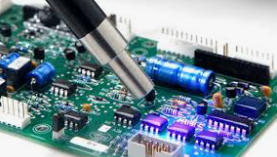UV PCBs are an advanced technology that utilizes ultraviolet (UV) light to manufacture printed circuit boards (PCBs). In recent years, this technology has garnered significant attention, becoming a key enabler for the miniaturization and high-performance development of electronic devices. UV light, with its short wavelength and high energy, is ideal for material curing and exposure processes. In particular, UV printed circuit boards (UV PCBs), which integrate UV LEDs into the circuit board, are widely used across various industries as highly efficient light sources.
First, let's understand the basics of UV PCBs. PCBs are substrates that connect electronic components, while UV PCBs incorporate LEDs and related components that generate UV light. UV light is primarily categorized into the following wavelengths: UV-A (315-400nm), UV-B (280-315nm), and UV-C (100-280nm). UV-C is particularly well-known for its powerful germicidal properties. Replacing traditional mercury lamps with UV LEDs can extend their lifespan, reduce power consumption, and minimize environmental impact. For example, mounting UV LEDs on a high-heat dissipation substrate called an MCPCB (metal core printed circuit board) can improve thermal management and enhance light output stability.
Next, we will explain the manufacturing process for UV-cured PCBs. In PCB manufacturing, UV light is crucial for curing and exposing photosensitive materials. First, copper foil is attached to the substrate, followed by a photosensitive film (photoresist). This film reacts to UV light. A mask with a circuit pattern is placed on this film and exposed in a UV exposure unit. The areas exposed to UV light are hardened, while unexposed areas are removed by an etching solution, resulting in a precise circuit pattern. This process is called photolithography and is also used in semiconductor manufacturing. Furthermore, when using UV-curable inks or coatings, the curing process can be completed within seconds to minutes through UV exposure. This method saves time and energy compared to traditional thermal curing methods. Furthermore, PCBs equipped with deep ultraviolet (DUV) LEDs produce short-wavelength light in the 200-280 nm range, making them ideal for precision processing. With the increasing automation of manufacturing processes, UV-cured PCBs have significantly improved production efficiency.

UV PCBs
UV PCBs offer numerous advantages. First, they are environmentally friendly. They contain no hazardous substances, such as mercury lamps, and are easily RoHS-compliant, enabling sustainable production. Furthermore, the low power consumption of UV LEDs reduces operating costs. Their rapid curing speed increases production line output, making them suitable for large-scale production. Furthermore, they can be applied to heat-sensitive materials, such as plastic components, preventing PCB board deformation and aging. Their high durability and stable UV exposure enhance product reliability. For example, during coating inspection, UV exposure triggers a fluorescent reaction, allowing visual confirmation of coating irregularities. This improves the accuracy of defective product detection and strengthens quality control. Disadvantages include high initial investment costs and difficulty controlling UV wavelength, but these issues are gradually being addressed through technological advances.
UV PCBs have a wide range of applications. Primarily, they are particularly prominent in disinfection and sterilization. UV-C light-activated PCBs are used in water treatment, air purification, and medical devices to effectively kill bacteria and viruses. Demand for this technology has surged since the outbreak of the COVID-19 pandemic. Secondly, in the industrial sector, they are used in adhesive and ink curing processes. UV-curable materials are used to coat automotive parts and protect the surfaces of electronic devices, and UV-lit PCBs serve as light sources for these applications. UV-lit PCBs are also used as sterilization lamps in the food and pharmaceutical industries to improve hygiene management. Furthermore, in semiconductor and optical film manufacturing, the precise patterning achieved by UV light irradiation is crucial. PCBs equipped with UV LEDs are also used as light sources for game development and multimedia devices, enabling the creation of innovative products. In the future, UV-lit PCBs are expected to play an increasingly important role in 5G communications and IoT devices, contributing to the realization of smart cities.
UV-lit PCBs represent a revolution in PCB manufacturing. The use of UV-lit PCBs improves efficiency, environmental friendliness, and versatility, providing broad support across various industries. With the continued development of UV LEDs, even more advanced applications are expected to emerge. Stay tuned for UV PCBs to illuminate the future of electronics.